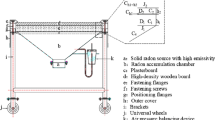Abstract
This paper will present a simple method for measuring the radon exhalation rate from the medium surface in two cycles and also avoiding the effects of back-diffusion and chamber leakage. The method is based on a combination of the “accumulation chamber” technique and a radon monitor. The radon monitor performs the measurement of the radon concentration inside the accumulation chamber, and then the radon exhalation rate can be obtained by simple calculation. For reducing the systematic error and the statistical uncertainty, too short of total measurement time is not appropriate, and the first cycle time should be about 70 % of the total measurement. The radon exhalation rate from the medium surface obtained through this method is in good agreement with the reference value. This simple method can be applied to develop and improve the instruments for measuring radon exhalation rate.


Similar content being viewed by others
References
Chen, C. L., & Oksza-Chocimowski, G. V. (1989). Periodicities of the radon level in Butte, Montana. Environmental Monitoring and Assessment, 13(1), 45–68.
Conen, F., Neftel, A., Schmid, M., & Lehmann, B. E. (2002). N2O/Rn-222-soil flux calibration in the stable nocturnal surface layer. Geophysical Research Letters, 29, 1025–1028.
Deynse, A. V., Cosma, C., & Poffijn, A. (1999). A passive radon dosimeter based on the combination of a track etch detector and activated charcoal. Radiation Measurements, 31, 325–330.
Dimova, N., Burnett, W. C., & Lane-Smith, D. (2009). Improved automated analysis of radon (222Rn) and thoron (220Rn) in natural waters. Environmental Science and Technology, 43, 8599–8603.
Hirsch, A. I., Michalak, A. M., Bruhwiler, L. M., Peters, W., Dlugokencky, E. J., & Tans, P. P. (2006). Inverse modelling estimates of the global nitrous oxide surface flux from 1998–2001. Global Biogeochemical Cycles, 20, GB1008.
Máduar, M. F., Campos, M. P., Mazzilli, B. P., & Villaverde, F. L. (2011). Assessment of external gamma exposure and radon levels in a dwelling constructed with phosphogypsum plates. Journal of Hazardous Materials, 190, 1063–1067.
Matuszek, J. M., Hutchinson, J. A., Lance, B. H., Virgil, M. G., & Mahoney, R. J. (1988). Standardization of radon measurements. Environment International, 14, 371–378.
Paschoa, A. S., Wrenn, M. E., & Torrey, J. A. (1984). A mathematical model of indoor radon and daughter. Radiation Protection Dosimetry, 7, 139–142.
Singh, B., Singh, S., Bajwa, B. S., Singh, J., & Kumar, A. (2011). Soil gas radon analysis in some areas of Northern Punjab, India. Environmental Monitoring and Assessment, 174, 209–217.
Tan, Y., & Xiao, D. (2011a). Revision for measuring the radon exhalation rate from the medium surface. IEEE Transactions on Nuclear Science, 58, 209–213.
Tan, Y., & Xiao, D. (2011b). A novel algorithm for quick and continuous tracing the change of radon concentration in environment. The Review of Scientific Instruments, 82, 043503–3.
Tan, Y., Xiao, D. (2012). Measuring radon exhalation rate through three cycles. Journal of Instrumentation, 7, doi:10.1088/1748-0221/7/08/T08004.
Tokonami, S., Furukawa, M., Shicchi, Y., Sanada, T., & Yamada, Y. (2003). Characteristics of radon and its progeny concentrations in air-conditioned office buildings in Tokyo. Radiation Protection Dosimetry, 106, 71–6.
Ujic, P., Celikovic, I., Kandic, A., & Zunic, Z. (2008). Standardization and difficulties of the thoron exhalation rate measurements using an accumulation chamber. Radiation Measurements, 43, 1396–1401.
Acknowledgments
The authors would like to thank Dr. Derek Lane-Smith for providing all the dimensions in RAD7. This project was supported by the National Natural Science Foundation of China (grant no. 11075049), the Excellent Talents Program of Hengyang Normal University of China, the construct program of the key discipline in Hunan Province, and Science Foundation of Hengyang Normal University of China (grant no. 11B41). The authors appreciate Mr. Aaron May for providing the language editing service.
Author information
Authors and Affiliations
Corresponding author
Rights and permissions
About this article
Cite this article
Tan, Y., Xiao, D. Measuring radon exhalation rate in two cycles avoiding the effects of back-diffusion and chamber leakage. Environ Monit Assess 185, 8759–8765 (2013). https://doi.org/10.1007/s10661-013-3210-7
Received:
Accepted:
Published:
Issue Date:
DOI: https://doi.org/10.1007/s10661-013-3210-7




